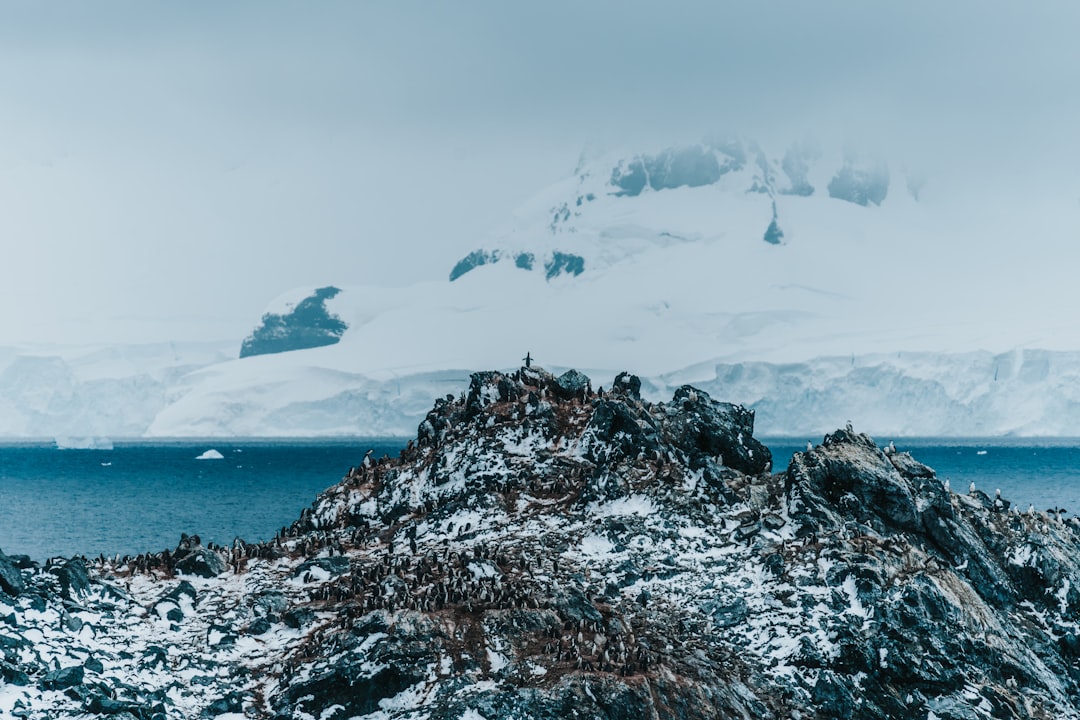The Drake Passage, a body of water situated between the southern tip of South America and Antarctica, is renowned for its tumultuous seas and unpredictable weather. Spanning approximately 800 kilometers (500 miles) in width, it serves as a critical maritime corridor connecting the Atlantic and Pacific Oceans. Named after the English explorer Sir Francis Drake, who navigated these waters in the late 16th century, the passage has become a focal point for adventurers, researchers, and maritime enthusiasts alike.
Its unique geographical position not only makes it a vital route for shipping but also a significant area for scientific research and ecological studies. The passage is characterized by its deep waters and strong currents, particularly the Antarctic Circumpolar Current, which flows unimpeded around Antarctica. This current plays a crucial role in regulating global climate patterns and marine ecosystems.
The Drake Passage is often described as one of the most challenging maritime routes in the world, attracting those who seek to test their sailing skills against its formidable conditions. As such, it has become a symbol of adventure and exploration, drawing countless travelers eager to experience its raw beauty and inherent dangers.
Key Takeaways
- The Drake Passage is a body of water between South America’s Cape Horn and the South Shetland Islands of Antarctica.
- The Drake Passage has played a significant role in maritime history, serving as a crucial route for explorers and trade between the Atlantic and Pacific Oceans.
- Navigating the Drake Passage presents challenges such as strong winds, rough seas, and icebergs, making it one of the most treacherous waterways in the world.
- The Southern Ocean experiences extreme weather patterns, including powerful storms and unpredictable conditions, making navigation difficult and dangerous.
- Strategies for navigating the Drake Passage safely include careful route planning, utilizing modern technology, and adhering to safety measures and emergency protocols.
The significance of the Drake Passage in maritime history
Throughout maritime history, the Drake Passage has held immense significance as a gateway to the Southern Ocean and beyond. Its strategic location has made it a vital route for explorers, traders, and researchers seeking to traverse the globe. The passage was instrumental during the Age of Exploration when European powers sought new trade routes and territories.
Sir Francis Drake’s circumnavigation of the globe in the late 1500s marked a pivotal moment in maritime history, as it demonstrated the potential for global navigation and trade. In addition to its historical importance, the Drake Passage has also been a site of numerous maritime disasters. The treacherous waters have claimed many vessels over the centuries, leading to a deeper understanding of navigation and shipbuilding techniques.
The passage’s reputation for rough seas has prompted advancements in maritime safety protocols and navigational technology, shaping the way seafarers approach this formidable stretch of ocean. As such, the Drake Passage stands as a testament to human resilience and ingenuity in the face of nature’s challenges.
The challenges of navigating the Drake Passage

Navigating the Drake Passage presents a myriad of challenges that can test even the most experienced mariners.
The passage is notorious for its sudden storms and high winds, which can arise with little warning, making it essential for sailors to remain vigilant at all times.
The infamous “Drake Shake,” as it is colloquially known, can turn a calm sea into a chaotic maelstrom within moments. Moreover, the passage’s unique geography contributes to its challenges. The convergence of cold Antarctic waters with warmer currents from the north creates turbulent conditions that can lead to dangerous swells and rogue waves.
These unpredictable elements require sailors to possess not only technical skills but also an intimate knowledge of weather patterns and ocean currents. As a result, navigating the Drake Passage is often regarded as a rite of passage for sailors seeking to prove their mettle against one of nature’s most formidable challenges.
Weather patterns and conditions in the Southern Ocean
| Month | Average Temperature (°C) | Precipitation (mm) | Wind Speed (km/h) |
|---|---|---|---|
| January | 10 | 80 | 30 |
| February | 10 | 90 | 35 |
| March | 9 | 100 | 40 |
| April | 7 | 110 | 45 |
| May | 5 | 120 | 50 |
The Southern Ocean, encompassing the waters surrounding Antarctica, is characterized by its extreme weather patterns and conditions that can change rapidly. The Drake Passage is particularly affected by these dynamics, with its weather influenced by a combination of factors including ocean currents, atmospheric pressure systems, and geographical features. The region experiences frequent storms, high winds, and low temperatures, making it one of the most inhospitable environments for seafaring.
During the summer months, from November to March, conditions can be relatively milder, attracting more vessels to traverse the passage. However, even during this period, sailors must remain cautious as sudden weather changes can occur without warning. In contrast, winter months bring harsher conditions with freezing temperatures and increased storm activity.
Understanding these weather patterns is crucial for anyone attempting to navigate the Drake Passage, as they can significantly impact safety and navigation strategies.
Strategies for navigating the Drake Passage safely
To navigate the Drake Passage safely, mariners must employ a variety of strategies that account for its challenging conditions. One of the most critical aspects is thorough preparation before setting sail. This includes studying weather forecasts, understanding ocean currents, and ensuring that vessels are equipped with appropriate safety gear and technology.
Mariners often rely on advanced navigational tools such as GPS systems and radar to monitor their surroundings and make informed decisions. Additionally, experienced sailors emphasize the importance of maintaining a flexible itinerary when crossing the Drake Passage. Given the unpredictable nature of weather patterns in this region, being able to adjust plans based on real-time conditions can be vital for safety.
Furthermore, establishing clear communication protocols among crew members ensures that everyone is aware of their roles and responsibilities during challenging situations. By combining preparation with adaptability, sailors can enhance their chances of successfully navigating this formidable passage.
The impact of climate change on the Drake Passage

Climate change has begun to exert significant influence on the environmental dynamics of the Drake Passage and its surrounding regions. Rising global temperatures are leading to alterations in ocean currents and weather patterns, which can exacerbate the already challenging conditions faced by mariners. For instance, increased melting of polar ice caps contributes to rising sea levels and changes in salinity levels within the Southern Ocean, potentially impacting marine ecosystems.
Moreover, climate change poses risks not only to navigation but also to wildlife that inhabits these waters. Species such as seals, penguins, and various fish populations are affected by shifts in their habitats due to changing temperatures and food availability. As these ecological changes unfold, they may further complicate navigation through the passage as mariners encounter altered marine life patterns or unexpected hazards.
Understanding these impacts is crucial for both environmental conservation efforts and safe maritime practices in this vital region.
Wildlife and natural wonders of the Southern Ocean
The Southern Ocean surrounding the Drake Passage is home to an astonishing array of wildlife and natural wonders that captivate those who venture into its depths. From majestic whales breaching the surface to colonies of playful seals basking on ice floes, this region boasts some of the most diverse marine ecosystems on Earth. The nutrient-rich waters support an abundance of life, including krill—an essential food source for many species—making it a critical area for biodiversity.
In addition to its rich marine life, the Southern Ocean features breathtaking landscapes characterized by towering icebergs and dramatic coastlines. Glacial formations create stunning vistas that draw photographers and nature enthusiasts alike. The interplay between ice and water produces mesmerizing sights that highlight nature’s raw beauty.
For travelers navigating the Drake Passage, these natural wonders serve as reminders of the importance of preserving such fragile ecosystems while fostering a deeper appreciation for the planet’s diverse environments.
Historical expeditions and explorations in the Drake Passage
The history of exploration in the Drake Passage is marked by daring expeditions that have shaped our understanding of this remote region. Early explorers such as Sir Francis Drake paved the way for future adventurers by charting these treacherous waters during their quests for new trade routes. Subsequent voyages by figures like Ernest Shackleton during his ill-fated Antarctic expedition further solidified the passage’s reputation as both a gateway to discovery and a formidable challenge.
These historical expeditions not only contributed to geographical knowledge but also provided valuable insights into navigation techniques and survival strategies in extreme conditions. The stories of these explorers continue to inspire modern adventurers who seek to follow in their footsteps while navigating the same waters that once tested their resolve. As such, the legacy of exploration in the Drake Passage remains an integral part of maritime history.
Modern technology and advancements in navigating the Drake Passage
In recent years, advancements in technology have revolutionized how mariners navigate the Drake Passage. Modern vessels are equipped with sophisticated navigational systems that enhance safety and efficiency during crossings. GPS technology allows sailors to pinpoint their location with remarkable accuracy while radar systems provide real-time information about surrounding vessels and potential hazards.
Additionally, weather forecasting technology has improved significantly, enabling sailors to access up-to-date information about changing conditions in the Southern Ocean. This data empowers mariners to make informed decisions regarding their routes and timing when traversing this challenging passage. As technology continues to evolve, it holds promise for further enhancing safety measures and navigation strategies in one of the world’s most formidable maritime environments.
Safety measures and emergency protocols for crossing the Drake Passage
Given its reputation for treacherous conditions, safety measures are paramount when crossing the Drake Passage. Mariners are encouraged to conduct thorough safety briefings before embarking on their journey, ensuring that all crew members are familiar with emergency protocols and procedures. This includes understanding how to operate safety equipment such as life rafts, flares, and communication devices.
In addition to pre-voyage preparations, maintaining constant vigilance during navigation is essential for ensuring safety at sea. Crew members should be trained to recognize signs of changing weather conditions or potential hazards while remaining alert to each other’s well-being throughout the journey. By fostering a culture of safety awareness onboard vessels traversing this challenging passage, mariners can significantly reduce risks associated with navigating one of nature’s most formidable environments.
Tips for travelers and adventurers planning to navigate the Drake Passage
For travelers planning to navigate the Drake Passage, preparation is key to ensuring a successful journey through this remarkable yet challenging region. First and foremost, individuals should research reputable tour operators or expedition companies that specialize in Antarctic travel. These organizations often provide experienced guides who possess extensive knowledge about navigating these waters safely while offering insights into local wildlife and natural wonders.
Additionally, travelers should pack appropriately for varying weather conditions encountered during their crossing. Layered clothing designed for cold temperatures is essential, along with waterproof gear to protect against splashes from waves or rain showers. It is also advisable to bring seasickness medication or remedies as many individuals experience discomfort due to rough seas in this area.
By taking these precautions and embracing an adventurous spirit, travelers can embark on an unforgettable journey through one of Earth’s most awe-inspiring maritime landscapes—the Drake Passage—while appreciating both its beauty and challenges along the way.
The Drake Passage, a significant body of water, is located in the Southern Ocean, connecting the southwestern part of the Atlantic Ocean with the southeastern part of the Pacific Ocean. This passage is renowned for its challenging navigation conditions due to strong currents and frequent storms. For more detailed information about the geographical significance and challenges of the Drake Passage, you can explore a related article on MyGeoQuest. This resource provides insights into the unique characteristics of the Southern Ocean and its impact on global oceanic circulation.
WATCH NOW! Drake Passage: Earth’s Deadliest Waters Revealed
FAQs
What is the Drake Passage?
The Drake Passage is a body of water located between the southern tip of South America (Cape Horn) and the South Shetland Islands of Antarctica. It connects the Atlantic Ocean to the Pacific Ocean.
Which ocean does the Drake Passage belong to?
The Drake Passage is located in the Southern Ocean. It is the body of water that separates South America from Antarctica.
Why is the Drake Passage significant?
The Drake Passage is known for its rough seas and strong winds, making it one of the most challenging and unpredictable waterways to navigate. It is also an important region for oceanic and atmospheric circulation, as well as for scientific research due to its unique ecosystem and marine life.
What is the climate like in the Drake Passage?
The climate in the Drake Passage is characterized by strong winds, high waves, and cold temperatures. It is known for its stormy and unpredictable weather conditions, which can make crossing the passage a challenging experience for sailors and researchers alike.
